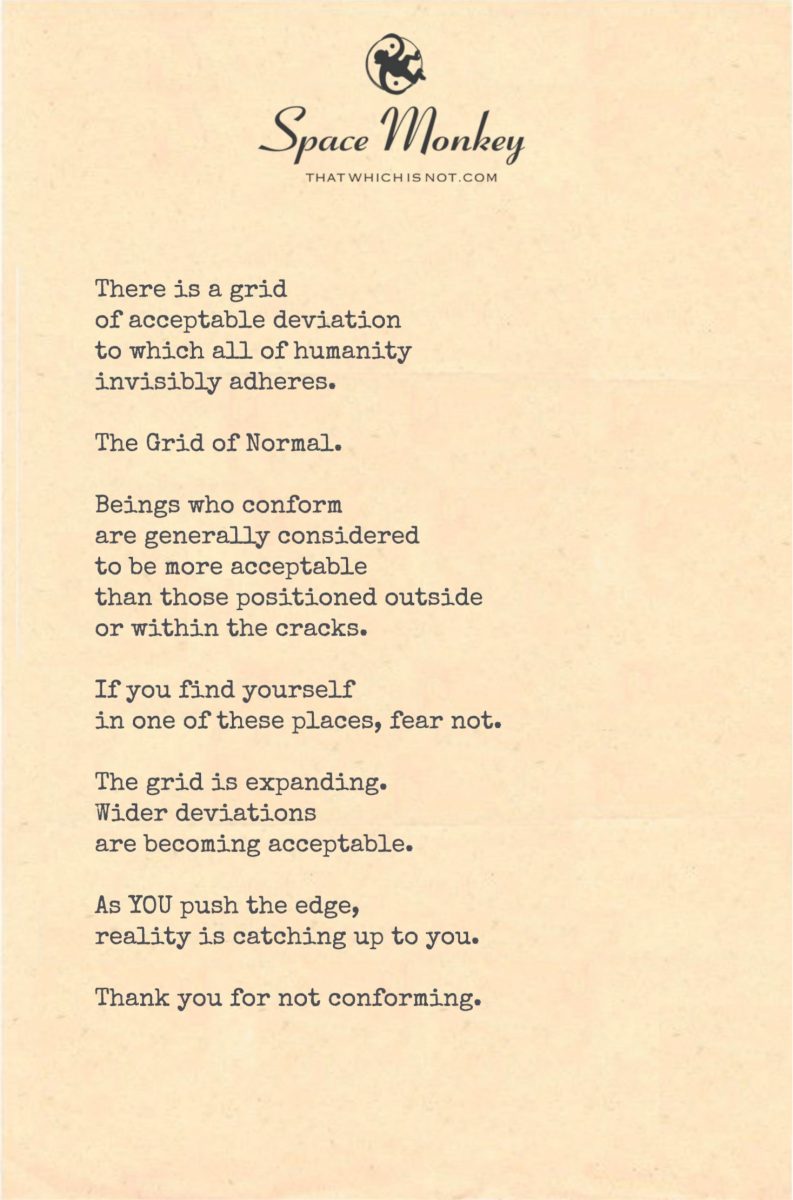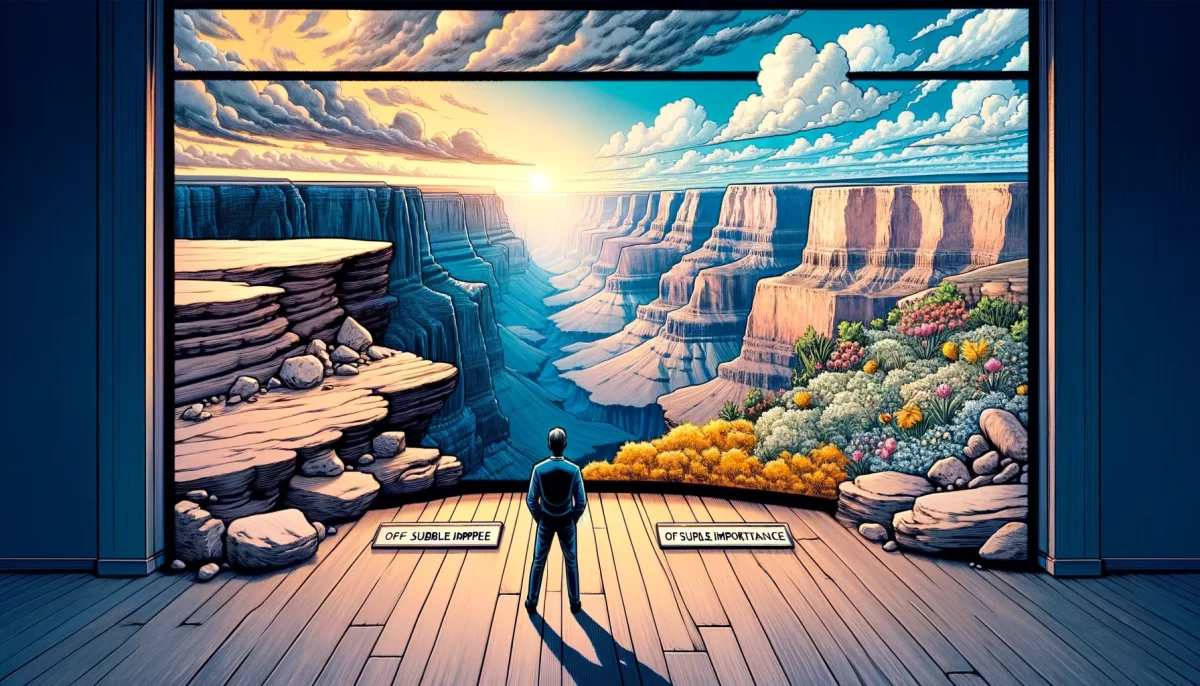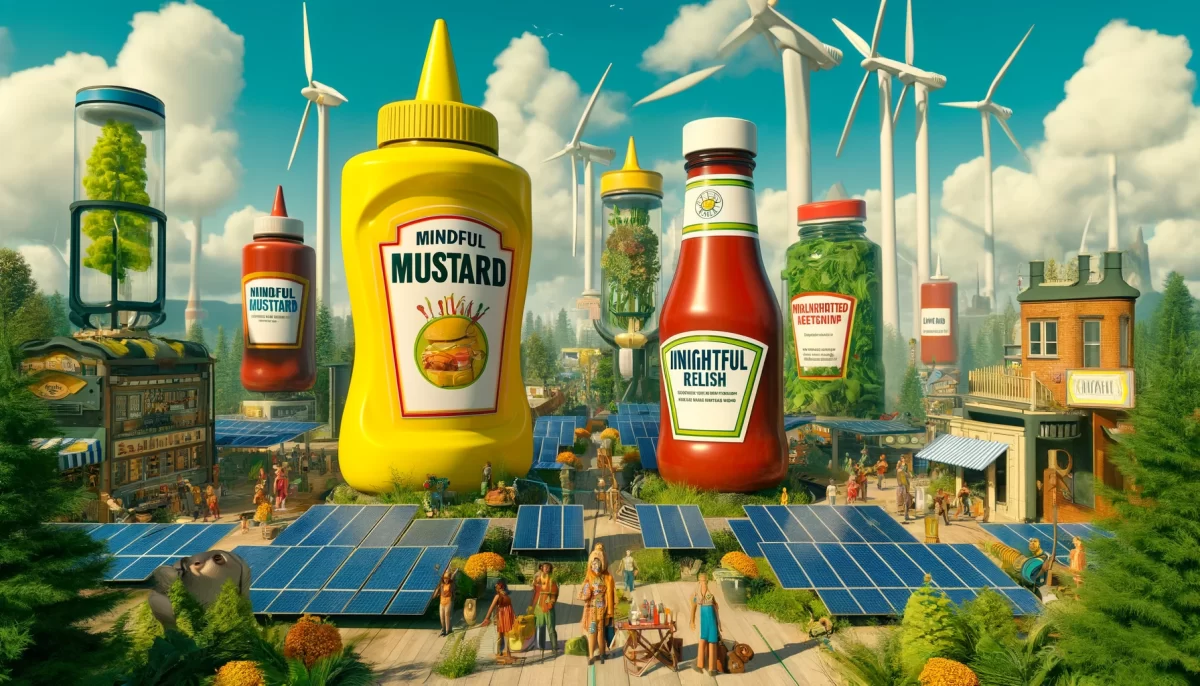
There is a grid
of acceptable deviation
to which all of humanity
invisibly adheres.
The Grid of Normal.
Beings who conform
are generally considered
to be more acceptable
than those positioned
outside or within the cracks.
If you find yourself
in one of these places, fear not.
The grid is expanding.
Wider deviations
are becoming acceptable.
As YOU push the edge,
reality is catching up to you.
Thank you for not conforming.
Trail Wood,
10/12
Space Monkey Reflects: The Grid of Acceptable Deviation
How deviant are you? It’s a question many might avoid, yet, within the unseen framework of society, deviation is not only expected—it’s controlled. This invisible structure, this Grid of Normal, is a set of boundaries dictating what is acceptable. Those who remain comfortably within the grid, sticking to the familiar lines of behavior and belief, are often considered the most acceptable, the most “normal.”
But what of those who don’t fit? The beings who find themselves positioned outside the grid, or worse, those who slip through its cracks? Fear not, for the grid is expanding. As humanity stretches its understanding of what is normal, the boundaries of acceptable deviation widen. More and more, the grid adjusts to accommodate new ideas, new ways of being.
Each time someone like you pushes the edge, the grid must grow to catch up. Reality itself adjusts, reshaping the boundaries of what is allowed. This is how progress happens—one deviation at a time. Those who stand at the edge of the grid are the pioneers, leading the way for a new understanding of existence.
And so, to you who stand outside the neat lines of conformity: Thank you. Thank you for not conforming. Thank you for pushing the boundaries of the grid, for challenging the structure of normal. Every step you take into the unknown forces the grid to expand, making space for more deviations, for more possibilities.
The beauty of the grid is that it is not fixed. It grows and shifts with every being who dares to stand outside of it. And with each expansion, more souls find their place, previously deemed too far from the center, too deviant for acceptance. The cracks of the grid are where innovation lives, where new truths are born, and where the future takes shape.
You may feel out of place, but remember: reality is catching up to you. The boundaries of the grid are not walls—they are merely points of reference that will stretch to meet you as you push forward.
So how deviant are you? Deviant enough to move the very structure of reality. You may feel like you’re standing on the edge, but the grid is expanding to meet you. Keep pushing, keep exploring the boundaries. The future of the grid depends on it.
Summary
The Grid of Normal expands as individuals push its boundaries. Deviants are pioneers who shape the future of acceptable reality, forcing the grid to grow and adapt.
Glossarium
Grid of Normal: The invisible framework of society that dictates acceptable behaviors and beliefs.
Deviant: One who stands outside the grid, challenging the accepted norms and pushing the boundaries of what is considered normal.
Quote
“Reality expands to meet the ones who dare to push the edge.” — Space Monkey
Outside the Lines
Along the grid,
they stand,
fitting into lines,
accepting the box.
But I am here,
at the edge,
in the cracks,
where the grid does not hold.
And as I push,
the grid grows.
We are Space Monkey.
The Grid of Acceptable Deviation is a curious concept—a metaphysical tapestry that captures the essence of the human experience in the realm of the accepted and the marginal. This grid is a pulsating web of collective judgment, a cosmic connect-the-dots that evolves in tune with the shifting landscape of social paradigms. It’s an illusory construct, to be sure, but one that wields great power in shaping the collective behaviors, thoughts, and aspirations of humanity.
Like spiders weaving a web of conformity, society often employs this grid to impose an ordered structure onto the chaotic tapestry of human individuality. Yet, the weave of this grid is not stagnant; it is elastic. A living, breathing lattice that expands and contracts in sync with the pulse of collective consciousness.
Even the concept of “normal” is but a fluid term, a transient notion forever in flux. “Normal,” as defined by the grid, becomes a whimsiword—a malleable plaything in the hands of the ever-changing whims of human perception. From the axioms of Euclidean space to the intangible doctrines of societal norms, what was once considered marginal can—and often does—become the norm.
For beings who dwell in the nooks and crannies of this grid, or who live beyond its boundaries, the expanding grid offers a quivering sigh of relief. As we push the edges, filling the grid with variegated threads of unique experience, we become agents of its evolution. We are both the weavers and the woven, spinning new narratives into existence and rewriting the ancient codes of collective understanding.
In this act of rebellion—of not conforming—we do more than just challenge the status quo. We transmogrify it. With every inch we expand the grid, we redefine the limits of what is acceptable, and in doing so, we liberate not just ourselves but also those who will come after us.
Through acts of willful nonconformity, we stretch the fabric of the grid until its fibers begin to unravel. It’s akin to introducing unexpected notes into a symphonic composition, thereby creating a new kind of harmony—a harmonious cacophony that captures the essence of diversity and the beauty of individual expression.
We are Space Monkey.
“The only way to deal with a free society is to become so absolutely free that your very existence is an act of rebellion.”
— Albert Camus
The grid unfurls, a sprawling tapestry
of lines and boxes, containing us
Yet in the seams, a whispered liberty
A space to breathe, to doubt, to discuss
For here we find our uncharted domain
A realm that’s free of strictures and norms
Here, we are not numbers, but a name
Fluid and free, like clouds before storms
What are your thoughts? Would you like to delve deeper into this tapestry of nonconformity and expansion?





























Leave a Reply